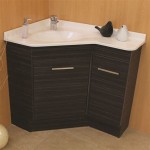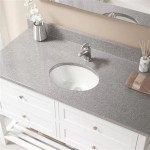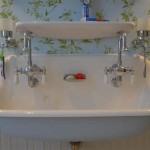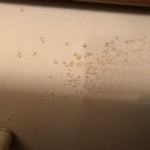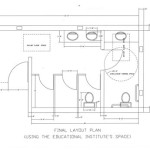I Have Ants In My Bathroom Sink: What To Do
Discovering ants in a bathroom sink can be a frustrating and unsettling experience. These tiny insects can appear suddenly and in large numbers, transforming a clean, private space into an unwelcome feeding ground. Understanding why ants are attracted to the bathroom sink, identifying the species involved, and implementing effective control measures are crucial steps in resolving the infestation. The presence of ants typically indicates an underlying issue, such as a food source or access point, that needs to be addressed to prevent future recurrences.
Ants are social insects that live in colonies, often with a designated queen and worker ants responsible for foraging. These worker ants scout for food, water, and shelter, using pheromone trails to guide their colony members to promising resources. The bathroom sink, despite its intended use for hygiene, can inadvertently provide these resources. Leftover toothpaste residue, water droplets, hair particles, and even soap scum can become attractants for ants seeking sustenance. Furthermore, the moist environment often found in bathrooms can create favorable conditions for ant nests, especially if there are cracks or crevices providing easy access.
Identifying the specific type of ant infesting the bathroom is helpful in choosing the most effective elimination methods. Some common household ants include sugar ants, pavement ants, and carpenter ants, each exhibiting slightly different behaviors and preferences. Sugar ants, as their name implies, are particularly drawn to sweet substances, while pavement ants are often found nesting in cracks in pavement and walls. Carpenter ants, conversely, are wood-destroying insects that may be attracted to moisture-damaged areas around the sink. Proper identification helps tailor the treatment strategy to target the ant species most effectively.
Identifying the Source of the Ant Infestation
Pinpointing the source of the ant infestation is the first and arguably most important step in eradicating the problem. Simply killing the visible ants in the sink only provides a temporary solution, as more ants will inevitably follow the pheromone trails left by their predecessors. A thorough inspection of the bathroom and surrounding areas is necessary to locate the nest or entry points. This inspection should focus on identifying potential food sources, water sources, and structural weaknesses that ants can exploit.
Begin by examining the area around the sink itself. Check for any food residue, such as toothpaste splatters or sugary spills. Ensure that the drain is clean and free of debris, as organic matter accumulated in the drain can attract ants. Inspect the faucets and pipes for leaks, as even small amounts of water can provide a vital water source for the ants. Pay close attention to the seals around the sink and counter, looking for any cracks or gaps that could serve as entry points.
Expand the inspection to the surrounding areas, including the walls, floors, and cabinets. Look for trails of ants leading to or from the bathroom. Check for any structural damage, such as cracks in the walls or floors, that could allow ants to enter. Examine the plumbing underneath the sink for leaks or dampness. If the bathroom is located near a kitchen or other area where food is prepared or stored, be sure to inspect those areas as well, as ants may be traveling from a distant food source.
Once the source of the infestation has been identified, it is important to address it directly. If there is a food source, such as spilled sugar or toothpaste, clean it up thoroughly. Repair any leaks or plumbing issues to eliminate water sources. Seal any cracks or gaps in the walls, floors, or around the sink to prevent ants from entering. By eliminating the attractants and access points, it becomes more difficult for ants to establish a colony in the bathroom.
Implementing Effective Ant Control Measures
Once the source of the infestation is addressed, implementing effective ant control measures is crucial to eliminate the existing ants and prevent future occurrences. These measures can range from simple, non-toxic methods to more aggressive chemical treatments, depending on the severity of the infestation and the preferences of the homeowner. The goal is to disrupt the ant colony and eliminate the ants without posing a significant risk to humans or pets.
One of the simplest and most effective methods is to clean the bathroom thoroughly and regularly. Wipe down surfaces to remove any food residue or water droplets. Keep the sink and drain clean and free of debris. Use a disinfectant cleaner to eliminate any pheromone trails left by the ants. This will help to deter other ants from following the same path.
Another effective method is to use bait stations. Bait stations contain a sweet or protein-based substance that attracts ants, along with a slow-acting poison that they carry back to their colony. Once the ants consume the bait and share it with the other members of the colony, the poison will eventually kill the entire colony. It is important to place the bait stations in areas where ants are commonly seen, but out of reach of children and pets. Avoid spraying insecticides around the bait stations, as this may deter the ants from taking the bait.
For more severe infestations, chemical treatments may be necessary. These treatments typically involve spraying insecticides around the perimeter of the bathroom, in cracks and crevices, and along ant trails. It is important to use insecticides that are specifically designed for ant control and to follow the instructions carefully. When using chemical treatments, it is important to ventilate the bathroom thoroughly and to keep children and pets away from the treated areas until the insecticide has dried.
Natural remedies can also be effective in controlling ants. For example, vinegar can be used to wipe down surfaces and disrupt ant trails. Borax can be mixed with sugar to create a homemade bait. Diatomaceous earth, a natural powder made from fossilized algae, can be sprinkled around areas where ants are seen. These natural remedies are generally safer than chemical treatments, but they may not be as effective for severe infestations.
Preventing Future Ant Infestations
After successfully eliminating an ant infestation, preventing future occurrences is essential to maintaining a clean and pest-free bathroom. This involves implementing preventative measures that address the underlying factors that attract ants, such as food sources, water sources, and access points. By making the bathroom less hospitable to ants, it is possible to significantly reduce the risk of future infestations.
One of the most important preventative measures is to maintain a clean and tidy bathroom. Wipe down surfaces regularly to remove any food residue, water droplets, or soap scum. Keep the sink and drain clean and free of debris. Store toiletries and cleaning supplies in sealed containers. Vacuum or sweep the floor regularly to remove any crumbs or spilled liquids.
Another important preventative measure is to eliminate water sources. Repair any leaks or plumbing issues promptly. Dry the sink and counter after each use. Use a dehumidifier to reduce humidity in the bathroom. Ensure that the bathroom is well-ventilated to prevent moisture buildup.
Sealing any cracks or gaps in the walls, floors, or around the sink is also crucial for preventing future infestations. Use caulk or sealant to fill any openings that could serve as entry points for ants. Inspect the bathroom regularly for new cracks or gaps and seal them promptly. Consider installing door sweeps or weather stripping to prevent ants from entering under the door.
In addition to these measures, it is also helpful to monitor the bathroom regularly for any signs of ant activity. If you notice any ants, take action immediately to eliminate them before they have a chance to establish a colony. By being proactive and vigilant, it is possible to keep the bathroom free of ants and other pests.
The type of cleanser used in the bathroom can also indirectly affect ant presence. Sweet-smelling cleansers may inadvertently attract ants, while those with strong, repellent scents (like peppermint or eucalyptus) might deter them. Consider alternating cleansers or using those known for their insect-repelling properties in areas prone to ant infiltration. This isn't a foolproof method but can add another layer of protection against recurring issues.
Ultimately, addressing an ant infestation in the bathroom sink requires a multi-pronged approach that involves identifying the source of the infestation, implementing effective control measures, and preventing future occurrences. By following these steps, it is possible to eliminate the ants and maintain a clean and pest-free bathroom environment.

Boise Idaho Pest Control Pestcom

How To Stop Ants From Invading Your Bathroom Identification And Prevention Tips

Boise Idaho Pest Control Pestcom

How To Get Rid Of Tiny Ants In Your Bathroom

How To Get Rid Of Ants In The Bathroom Synergy²

Why Do I Have Ants In My Bathroom

How To Get Rid Of Ants In The Bathroom Certified Leak Detection Orlando

How To Get Rid Of Ants In Your House

How To Get Rid Of Ants A Complete Guide 2024

How To Get Rid Of Ants In The Bathroom 12 Easy Ways
Related Posts
